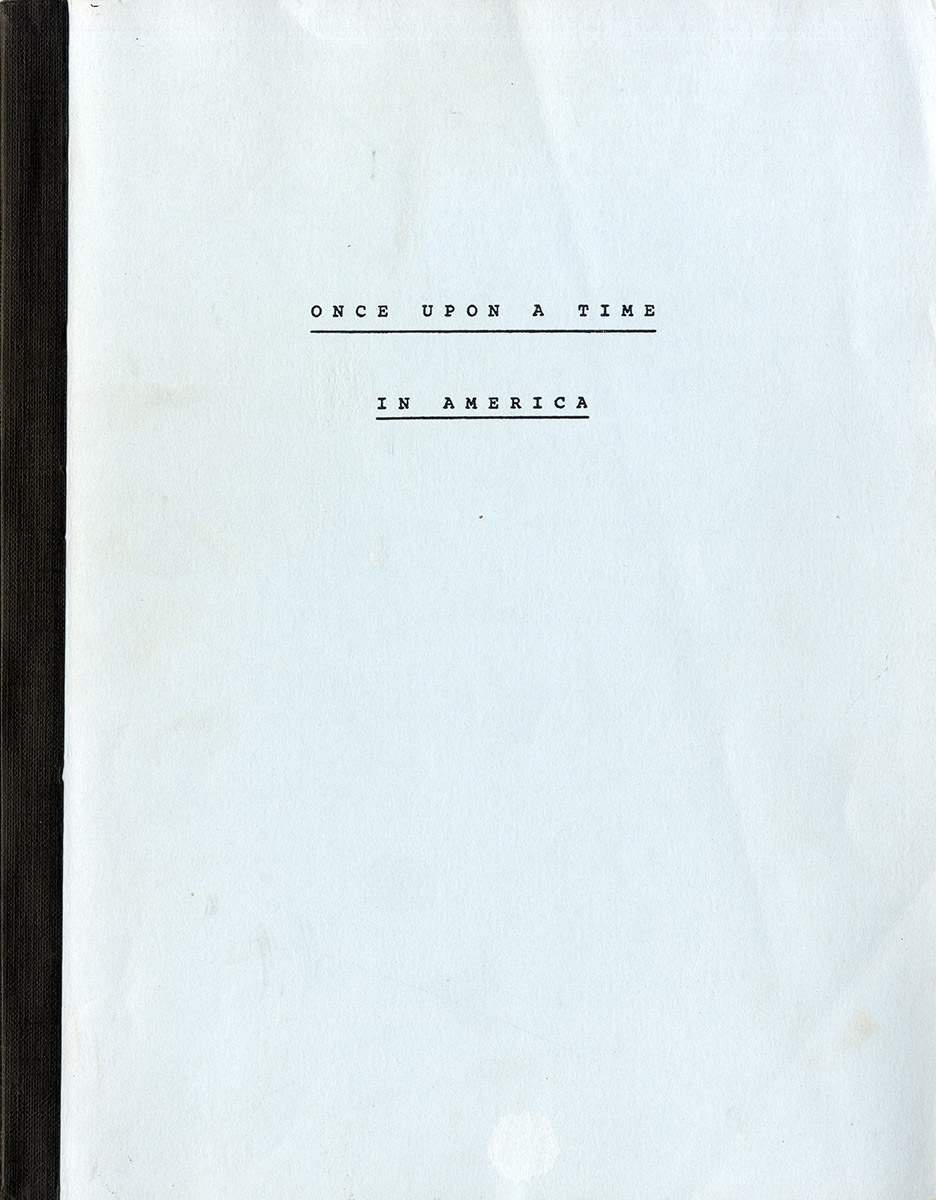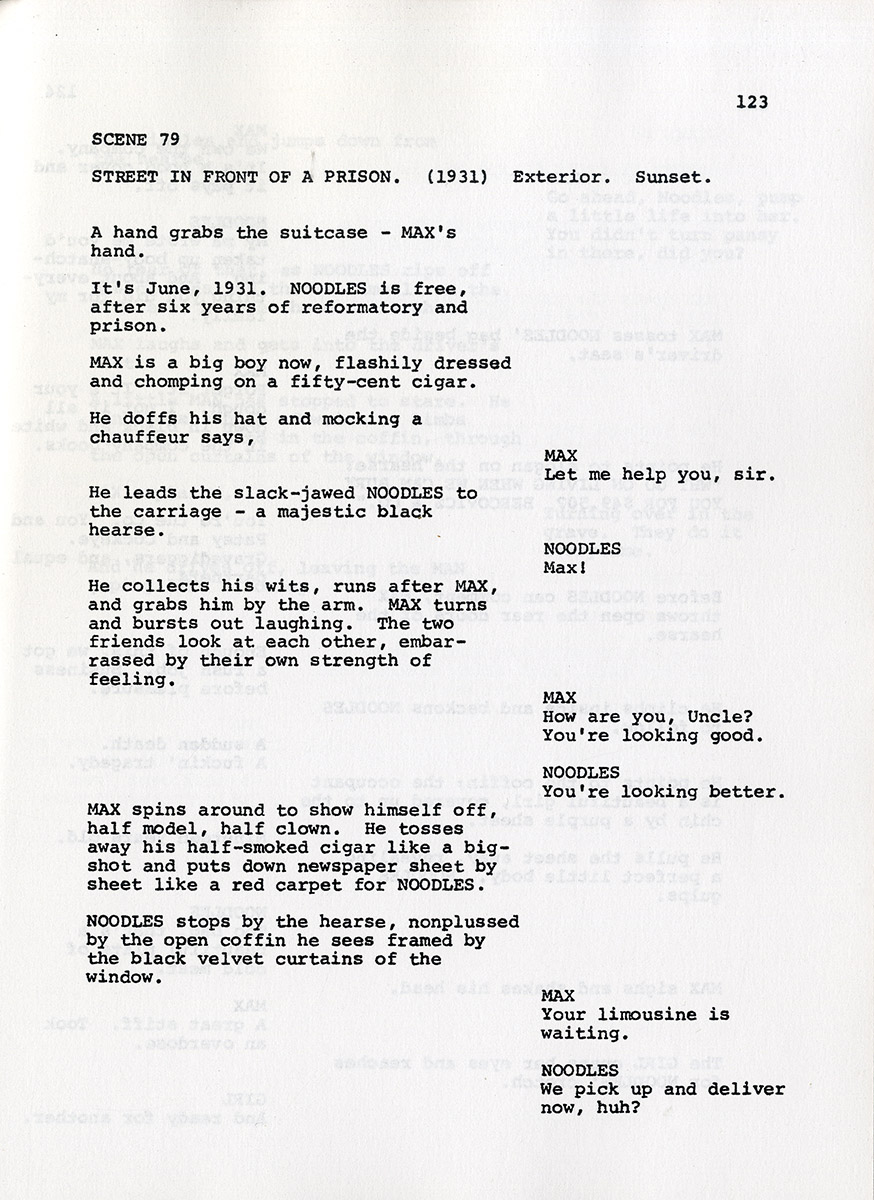Sergio Leone (director) ONCE UPON A TIME IN AMERICA (1983) Film script
Np, 1983. Vintage original film script, quarto, mimeograph, 264 pp., printed on rectos and versos, bound with cloth tape at spine, printed wrappers, just about fine.
Sergio Leone’s landmark epic gangster film.
ONCE UPON A TIME IN AMERICA is many things. It is an epic history of organized crime as seen through the eyes of characters based on Bugsy Siegel and Meyer Lansky. It is writer/director Sergio Leone’s loving homage to the American gangster genre. It is also, like most of Leone’s significant work, a look at male friendship and betrayal.
Its literary antecedents include Fitzgerald’s THE GREAT GATSBY (Robert De Niro plays a self-made Gatsby-like character pursuing an ever-receding American dream embodied in an unobtainable woman) and Proust’s REMEMBRANCE OF THINGS PAST (the obsession with time and memory: the film cuts back and forth between 1933, the 1920s and 1968, but since it begins and ends in a 1933 opium den, the whole story could be considered the De Niro character’s opium dream).
A dream project for filmmaker Leone, the movie was in development for roughly 16 years, from the late-1960s (Leone turned down an offer to direct THE GODFATHER in order to work on this project) to its release in 1984, going through multiple screenplay drafts with multiple writers. Star Robert De Niro devoted a year of his life to shooting the film, and was responsible for most of the American casting. Now considered a masterpiece, the film was released in several versions over the years with running times varying from 139 minutes (the initial American release) to 251 minutes (the most recent restoration).
Leone was a director known for both his extravagant visual style and his attention to sound and music, and the format of this screenplay reflects this. The entire 264 page screenplay is divided into two columns – the left column provides a detailed description of the visuals, what we are going to see on the screen, while the right column shows the accompanying dialogue, sound effects, and significant musical cues. (This type of two-column screenplay is, in fact, a standard practice in Italian cinema.)
Moreover, instead of being broken down into angles or shots, the screenplay is broken down into unitary scenes, with each scene identified by time and location —
SCENE 1 – SHADOW PUPPET THEATER. (1933) Interior. Night.
SCENE 2 – NOODLES’ HOTEL ROOM. (1933) Interior. Night.
SCENE 3 – SHADOW PUPPET THEATER. (1933) Interior. Night.
[again]
SCENE 4 – OFFICE AT FAT MOE’S SPEAKEASY. (1933) Interior.
Night.
— and so on.
We can see an immediate difference between this screenplay draft and the director’s cut of the film with respect to the ordering of scenes. The film, instead of beginning with the Chinese Puppet Theater/Opium Den (as above), begins with the scene in Noodles’ Hotel Room where Eve (Darlanne Fluegel) is killed, followed by the scene in Fat Moe’s office. Only then do we cut for the first time to the Puppet Theater/Opium Den where Noodles (De Niro) is hiding out. However, the scenes themselves are filmed almost exactly as described in the screenplay’s visual column.
This screenplay draft also contains scenes that have not appeared in any released cut of the film to date, for example, “Scene 26 – SYNAGOGUE (1968) Interior. Day,” wherein Noodles asks some rabbis in a synagogue about a letter he received concerning the reinterment of his deceased friends, which it turns out the synagogue did not send. Given that Leone’s original cut of the film was 6 hours long, it is safe to assume that this script contains various scenes that were originally shot, but did not appear in the director’s cut of the film.
Out of stock
Related products
-
![(Blaxploitation film) BLACK BELT JONES [1974] Film script by Oscar Williams](https://www.walterfilm.com/wp-content/uploads/2024/06/BlackBeltJonesSCR_a-540x693.jpg)
(Blaxploitation film) BLACK BELT JONES [1974] Film script by Oscar Williams
$750.00 Add to cart -
![ESCAPADE [working title for: A WARM DECEMBER] (Jun 11, 1971) Revised First Draft screenplay](https://www.walterfilm.com/wp-content/uploads/2021/04/EscapadeSCR_a-540x695.jpg)
ESCAPADE [working title for: A WARM DECEMBER] (Jun 11, 1971) Revised First Draft screenplay
$500.00 Add to cart -

Sidney Lumet (director) PRINCE OF THE CITY (Jan 1980) Final Draft film script
$950.00 Add to cart -

Carson McCullers (source) THE HEART IS A LONELY HUNTER (Aug 26, 1963) Film script by Thomas C. Ryan
$1,000.00 Add to cart


